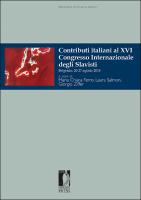Contributi italiani al XVI Congresso Internazionale degli Slavisti
(Belgrado 20-27 agosto 2018)
| dc.contributor.editor | Ferro, Maria Chiara | |
| dc.contributor.editor | Salmon, Laura | |
| dc.contributor.editor | Ziffer, Giorgio | |
| dc.date.accessioned | 2022-05-31T10:31:11Z | |
| dc.date.available | 2022-05-31T10:31:11Z | |
| dc.date.issued | 2018 | |
| dc.identifier | ONIX_20220531_9788864537238_767 | |
| dc.identifier.issn | 2612-7679 | |
| dc.identifier.uri | https://library.oapen.org/handle/20.500.12657/55483 | |
| dc.language | Italian | |
| dc.relation.ispartofseries | Biblioteca di Studi Slavistici | |
| dc.subject.other | Slavic Studies | |
| dc.subject.other | literature | |
| dc.subject.other | linguistics | |
| dc.subject.other | MKS | |
| dc.subject.other | slavonic cultures | |
| dc.title | Contributi italiani al XVI Congresso Internazionale degli Slavisti | |
| dc.title.alternative | (Belgrado 20-27 agosto 2018) | |
| dc.type | book | |
| oapen.abstract.otherlanguage | The twenty-three essays of this volume represent the contributions of the Italian delegation to the 16th International Congress of Slavic Studies, which took place in Belgrade in August 2018. The essays, written in Italian, English, Russian and Serbian, are divided into three sections: linguistics, philology and Slavic literatures. Just as the range of the touched topics is very wide, so is their time span, going from the prehistoric and protohistoric eras to the present day. The covered topics extend from the Proto-Slavic language to the writing, linguistic and literary traditions of the Slavic ecclesiastical civilization, from the linguistic and cultural relations between Italy and Russia to a particular 18th-century Illyrian dictionary. In the field of synchronic linguistics, the essays include: a study of dialectology and sociolinguistics in the borderland between Ukraine and Belarus; the ways to express the concept of completeness in Russian; the study of some concessive constructs of the Russian language using the methods of “constructionist grammar”, a particular aspect of the Russian and Bulgarian verbal systems; and finally, the different suffixes used in the formation of the aspectual pairs in the Resian dialect. In the literary field, the essays topics range from Gumilev and Chlebnikov to literature and ecology; from Armenian writers who write in Russian to the neo-Latin poem “The bison’s song” and to the humanistic and Renaissance reflections in modern Ukrainian literature; from an Italian scholar of Serbian literature in the first half of the 20th century to the image of the “strong woman” in the Serbian literature of the same time. Therefore, thanks to their variety, these essays offer a very concrete idea of the several existing currents within the research in Slavic Studies in Italy. | |
| oapen.identifier.doi | 10.36253/978-88-6453-723-8 | |
| oapen.relation.isPublishedBy | bf65d21a-78e5-4ba2-983a-dbfa90962870 | |
| oapen.relation.isbn | 9788864537238 | |
| oapen.relation.isbn | 9788864537207 | |
| oapen.relation.isbn | 9788892731080 | |
| oapen.series.number | 40 | |
| oapen.pages | 356 | |
| oapen.place.publication | Florence |

